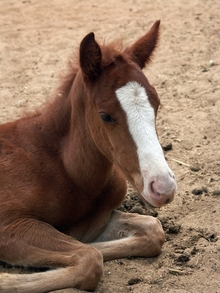Since newly-born foals are rather helpless, a foal that is unable to stay with its natural mother for any reason needs special care to ensure appropriate growth and development. Raising an orphaned foal to the age of a weanling is a challenge because of its feeding and socialization requirements.

A healthy, well-adjusted foal
Raising an orphaned foal to the age of a weanling is a challenge because of its feeding and socialization requirements, but with proper management the orphaned foal can grown into a sound and well-adjusted horse.
Foals become orphans when the mare dies during or after delivery of serious complications related to the pregnancy. In some cases, the mare may reject the foal and sometimes the foal has to be removed from the dam because of age, breeding status, or other complicating factors
Good horse management and knowledgeable horse selection may minimize the number of orphan foals, but the death of a dam, or having to remove a foal because of complications related to pregnancy and delivery, can not always be prevented.
Several options exist for dealing with orphan foals. Of primary concern immediately following delivery is making sure that the foal receives alternative colostrum within the first six hours of life. Placement with a "nurse" foster mare that is in the early stages of lactation is the most satisfactory solution, but is not always possible. Another option is the use of frozen colostrum.
If the foal is not able to suckle shortly following delivery, colostrum should be administered via tubing.
Foals suckle intermittently and the feeding of the colostrum should occur approximately every hour. Having a veterinarian check the immunoglobulin status to determine if the proper IgG count of 1,000 to 1,300 is reached will provide information regarding transfer of immunity. Foals may require extra colostrum or, in some cases, plasma as a substitute.
When providing nourishment for the growing foal through placement with a nurse mare, care should be taken to ensure the mare's milk will meet the needs of the foal. The growth rate of the foal is dependent upon energy and protein intake, and if a good match is not made, skeletal and other problems related to healthy growth may develop.
Since mares produce higher levels of proteins, lipids, and lactose immediately after foaling, matching the foal with a mare that has been lactating for a long period of time may not be the best choice.
Using a milk replacer is another alternative for raising orphan foals. In the past, complications with digestion have been linked to milk replacers, but these problems have been resolved by the development of better formulas.
The amount of time and labor required of the handler when using milk replacers is a drawback. Since the digestive tract of a foal is simple and undeveloped, small quantities of milk need to be fed often to allow the digestive system to absorb the sugars and protein in the milk without leading to diarrhea and other problems.
A knowledgeable veterinarian can work out a timetable for these feedings and can recommend the best milk replacer to be used. Foals being fed milk replacer should be offered small quantities of high-quality feed beginning at approximately two weeks of age. Gradually, the amount of feed can be increased and the amount of milk replacer reduced.
In addition to good nutrition and proper feeding schedules, orphan foals will need to be socialized. If a nurse mare is on the scene, socializing will most likely develop naturally with the mare's attention. If not, a pony or other horse may serve as a role model. In some cases, nanny goats have been used successfully in this role.
As the foal grows, proper management can make the difference between a healthy, well-adjusted horse and a maladjusted horse that develops stereotypies and other problematic behaviors.
Here are additional management tips to keep the foal healthy both mentally and physically:
- Unless there is a medical concern, provide youngsters free choice exercise daily
- The less time foals are confined to stalls, the better. Avoid confining foals for more than 10 hours per day.
- Use longeing, round pen or treadmill work judiciously. Excessive forced exercise can strain joints and limbs.
- Never exercise a foal to the point of fatigue. If you observe a foal’s limbs to be shaking, weak, or if the mare cannot keep up with the adult horses in a herd, the mare and foal need to be confined until the foal is rested.
- Keep the foal's feet properly trimmed to foster proper bone development.
- Provide a clean, safe environment with adequate shelter from the elements
- Check the foals's surroundings and eliminate any potential hazards such as loose boards, nails, wire fencing or equipment.
The reward for providing excellent nutrition, conscientious care and a safe environment will be a healthy foal that grows into a sound and useful horse.
